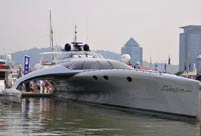An outlier or a trend
Commenting on the high price of The Last Supper, Bao sees it as a result of many factors - a special piece sold at a special time.
"The Mask series and the Xiehe Hospital series were both special," he said.
Bao explained that Zeng changes style about every five years. Works of the Mask series were created from 1996 to 2001 and after The Last Supper, Zeng went through a transition period and later started an expressionistic landscape series.
He finds that it is also a special time now with things happening such as the launch of the first Chinese mainland auction of Christie's and the China (Shanghai) Pilot Free Trade Zone, which may all influence the art market.
Evelyn Lin, Sotheby's head of contemporary Asian art, told the Global Times that the predicted price was HK$80 million, which was based on previous dealing records.
According to Lin, the fact that The Last Supper had been part of the collection of the Ullens couple Baron and Baroness Guy Ullens de Schooten since 2002 might have also played a role in this exceptional result.
"The collectors know about the Ullens and know about this particular work as the most famous one in Zeng's Mask series - the biggest one, which portrayed the largest number of people," said Lin.
She also mentioned that what is interesting about the work is the time period it represents.
Inspired by Leonardo da Vinci's world-renowned mural, Zeng transforms Judas into a man wearing a golden tie.
"The golden tie is a representation of capitalism, ... which suggests China's transition to capitalism," Lin interpreted.
With the attention comes controversy. Some critics say that the political connotations of the Mask series exceed its artistic value.
Bao sees the myriad connotations behind the series as a typical feature of contemporary art - the thoughts, ideas and interpretations are as important as the technique.
The 100 million era
Are we standing in the middle of a 100 million yuan era? The question has been asked by both media and critics since 2010 when several works from Qi Baishi and Li Keran entered the 100 million yuan category.
Wu Jin, editor-in-chief of Hi Art magazine, explained that although The Last Supper was sold at an unexpectedly high price, there were still works of art that were more expensive than The Last Supper in Sotheby's auctions lately.
There were also new personal records for other artists including Zao Wou-ki, Pan Yuliang and Liu Ye on the same night The Last Supper was sold.
For most living Chinese artists, the price of Zeng's The Last Super is a boost in confidence, but the effect won't be a direct one.
For Lin, The Last Supper is a special case because a healthy market cares more about the importance of individual work rather than the popularity or recognition of the artist.
In recent years, Zeng has continued to put out exhibitions internationally. As a result, his artwork increasingly is considered a good choice for both new and experienced collectors.
"I don't think many other contemporary artworks would be able to enter the 100 million yuan category," she said.
In a 2011 interview with TV host Yang Lan, Zeng said that there were buyers offering to pay 100 million yuan for 20 pieces of his Mask series.
Zeng once spent more than 10 million yuan to repurchase a work he did in his third year of undergraduate studies.
He probably knows the best that once a piece of art arrives in the market, whether through art galleries or auction houses, its no longer in the control of the artist, unless it is bought back.

 2013 Colour Me Rad 5K run held in Canada
2013 Colour Me Rad 5K run held in Canada China's destroyer Qingdao sails out of Sydney Harbor
China's destroyer Qingdao sails out of Sydney Harbor Chinese tycoon aims to restore London's Crystal Palace
Chinese tycoon aims to restore London's Crystal Palace Worst flooding hits Yuyao, 70% of downtown area underwater
Worst flooding hits Yuyao, 70% of downtown area underwater Game for the brave: 'Spiders' in Yandang Mountains
Game for the brave: 'Spiders' in Yandang Mountains Hungarian wingsuit flyer confirmed dead in Zhangjiajie
Hungarian wingsuit flyer confirmed dead in Zhangjiajie Chinese screen goddesses from Beijing Film Academy
Chinese screen goddesses from Beijing Film Academy  Weekly Sports Photos
Weekly Sports Photos World's most amazing yacht on display in Guangzhou
World's most amazing yacht on display in Guangzhou Photo collection of Chinese Navy
Photo collection of Chinese Navy Photo story: Young tenants in Beijing
Photo story: Young tenants in Beijing Twins Culture Festival kicks off in Beijing
Twins Culture Festival kicks off in Beijing UNESCO world heritage site: Montale Tower
UNESCO world heritage site: Montale Tower Israeli drone crashes into Mediterranean, fragments recovered
Israeli drone crashes into Mediterranean, fragments recovered Fiber-optic wedding dress show shinning in Suzhou
Fiber-optic wedding dress show shinning in Suzhou Day|Week|Month